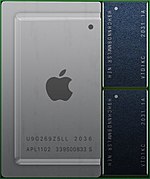Apple M2
This article has multiple issues. Please help improve it or discuss these issues on the talk page. (Learn how and when to remove these messages)
|
 | |
| General information | |
|---|---|
| Launched | June 24, 2022 |
| Designed by | Apple Inc. |
| Common manufacturer | |
| Performance | |
| Max. CPU clock rate | 3.49 GHz[citation needed] |
| Cache | |
| L1 cache | 192+128 KB per core (performance cores) 128+64 KB per core (efficient cores) |
| L2 cache | 16 MB (performance cores) 4 MB (efficient cores) |
| Last level cache | 8 MB |
| Architecture and classification | |
| Application | Notebook (MacBook family), Tablet (iPad Pro) |
| Technology node | 5 nm (N5P) |
| Microarchitecture | "Avalanche" and "Blizzard" |
| Instruction set | ARMv8.5-A[citation needed] |
| Physical specifications | |
| Transistors |
|
| Cores |
|
| GPUs | Apple-designed integrated graphics 8 or 10 core GPU |
| Products, models, variants | |
| Variant | |
| History | |
| Predecessor | Apple M1 |
| Mac transition to Apple silicon |
|---|
 |
The Apple M2 is an ARM-based system on a chip (SoC) designed by Apple Inc. as a central processing unit (CPU) and graphics processing unit (GPU) for its Mac notebooks and the iPad Pro tablet. It is the second generation of ARM architecture intended for Apple's Mac computers after switching from Intel Core to Apple silicon, succeeding the M1. Apple announced the M2 on June 6, 2022, at WWDC, and released on June 24, 2022. Along with models of the MacBook Air and the 13-inch MacBook Pro using the M2. The M2 is made with TSMC's "Enhanced 5-nanometer technology" N5P process and contains 20 billion transistors, a 25% increase from the M1. Apple claims CPU improvements up to 18% and GPU improvements up to 35% compared to the M1.[1]
See also
▲
Notes
References
- ^ "Apple unveils M2, taking the breakthrough performance and capabilities of M1 even further" (Press release). Apple. June 6, 2022.
Design
CPU
The M2 has four high-performance "Avalanche" and four energy-efficient "Blizzard" cores, first seen in the A15 Bionic, providing a hybrid configuration similar to ARM DynamIQ and Intel's Alder Lake and Raptor Lake processors. The high-performance cores have an unusually large 192 KB of L1 instruction cache and 128 KB of L1 data cache and share a 16 MB L2 cache; the energy-efficient cores have a 128 KB L1 instruction cache, 64 KB L1 data cache, and a shared 4 MB L2 cache. It also has an 8 MB system level cache shared by the GPU.
GPU
The M2 integrates an Apple designed ten-core (or eight-core) graphics processing unit (GPU). Each GPU core is split into 32 execution units, which each contain eight arithmetic logic units (ALUs). In total, the M2 GPU contains up to 320 execution units or 2,560 ALUs, which have a maximum floating point (FP32) performance of 3.6 TFLOPs.
Memory
The M2 uses 6,400 MT/s LPDDR5 SDRAM in a unified memory configuration shared by all the components of the processor. The SoC and RAM chips are mounted together in a system-in-a-package design. 8 GB, 16 GB and 24 GB configurations are available. It has a 128-bit memory bus with 100 GB/s bandwidth.
Other features
The M2 contains dedicated neural network hardware in a 16-core Neural Engine, capable of executing 15.8 trillion operations per second. Other components include an image signal processor, a PCIe storage controller, a USB4 controller that includes Thunderbolt 3 support, and a Secure Enclave.
Supported codecs on the M2 include 8K H.264, 8K H.265 (8/10bit, up to 4:4:4), 8K Apple ProRes, VP9, and JPEG.
Performance and efficiency
This section contains promotional content. (November 2022) |
The M2 features faster performance cores and a larger cache than its predecessor, while the efficiency cores have been improved for greater performance gains than its predecessor.[1]
Compared to the CPU of the Intel Core i7-1255U, the M2's CPU delivers nearly twice the performance at the same power consumption level. It delivers the peak performance with a quarter of its power consumption level.[1][note 1]
Compared to the CPU of the Intel Core i7-1260P, the M2's CPU delivers nearly 90 percent of the peak performance with a quarter of its power consumption level.[1][note 2]
Compared to the GPU in the Intel Core i7-1255U, the M2's GPU delivers 2.3 times faster performance at the same power consumption level and matches its peak performance with a fifth of its power consumption level.[1][note 3]
Products that use the Apple M2 series
M2
- MacBook Air (M2, 2022)
- MacBook Pro (13-inch, M2, 2022)
- iPad Pro (11-inch, 4th generation) (2022)
- iPad Pro (12.9-inch, 6th generation) (2022)
See also
Cite error: There are <ref group=note> tags on this page, but the references will not show without a {{reflist|group=note}} template (see the help page).
